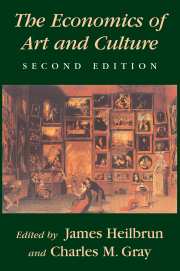Book contents
- Frontmatter
- Contents
- List of figures and tables
- Preface
- Part I The arts sector: Size, growth, and audiences
- 1 An overview of the arts sector
- 2 Growth of the arts sector
- 3 Audiences for the arts
- Part II The microeconomics of demand and supply
- Part III The fine arts and museums
- Part IV Public policy toward the arts
- Part V Art, economy, and society
- Index
3 - Audiences for the arts
Published online by Cambridge University Press: 05 September 2012
- Frontmatter
- Contents
- List of figures and tables
- Preface
- Part I The arts sector: Size, growth, and audiences
- 1 An overview of the arts sector
- 2 Growth of the arts sector
- 3 Audiences for the arts
- Part II The microeconomics of demand and supply
- Part III The fine arts and museums
- Part IV Public policy toward the arts
- Part V Art, economy, and society
- Index
Summary
In Chapter 2 we measured the growth of the arts by examining trends in consumer spending for admissions. In a free-enterprise economy, consumer spending is the principal source of what economists define as the demand for the arts. It is the source of box office receipts for theaters, concerts, opera, and ballet, the admissions and art shop income of museums, and the royalty income of performing arts companies from the sale of records and tapes. Since these forms of demand originate with the people who attend performances, visit museums, or buy reproductions of art or recordings of music, surveys of arts audiences contribute importantly to an understanding of the economics of the arts.
Arts organizations now display much greater marketing sophistication than in the past. Theater managers, before establishing a range of ticket prices, want to know what kinds of people make up their audience. As we explain in Chapter 4, some people are more price-sensitive than others. Museum directors want to know what sort of visitors they are attracting. Business managers of ballet and opera companies want to find out whether they can count on attracting audiences from among those who habitually attend other kinds of performing arts. Officials at all levels of government that provide public subsidies for the arts need to know the extent to which various subgroups in the local or national population participate in arts activities.
- Type
- Chapter
- Information
- The Economics of Art and Culture , pp. 40 - 58Publisher: Cambridge University PressPrint publication year: 2001



